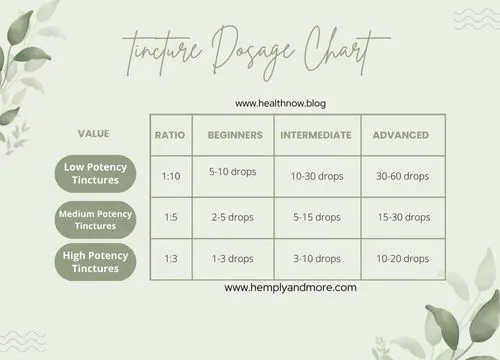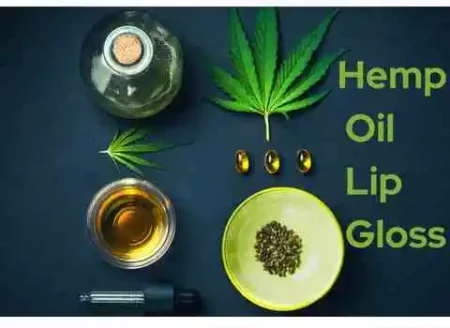Tinctures have gained significant popularity as an alternative method of consuming herbal and medicinal remedies. With the increasing interest in natural treatments, medicines offer a convenient and efficient way to consume your favourite herbs, ensuring a controlled dosage and quick absorption. This blog will provide a comprehensive tincture dosage chart to help you start your tincture journey.
How Much Tincture Dosage
Before diving into the dosage chart, it’s essential to note that the potency of Tinctures may vary depending on the herb used and the extraction method. It’s advisable to commence with a lower dosage and progressively raise it until you discover the ideal quantity that suits you best.
Here’s a general tincture dosage chart to get you started:
- Low Potency Tinctures (1:10 ratio):
- Beginners: 5-10 drops
- Intermediate: 10-30 drops
- Advanced: 30-60 drops
- Medium Potency Tinctures (1:5 ratio):
- Beginners: 2-5 drops
- Intermediate: 5-15 drops
- Advanced: 15-30 drops
- High Potency Tinctures (1:3 ratio):
- Beginners: 1-3 drops
- Intermediate: 3-10 drops
- Advanced: 10-20 drops

The tincture dosage chart provided earlier is a general guideline to help you understand the various potency levels and recommended dosages for beginners, intermediate, and advanced users. Nevertheless, it’s crucial to remember that personal elements like body weight, age, metabolism, and sensitivity can impact the appropriate dosage for you. Let’s delve deeper into each potency level to provide a more comprehensive understanding of tincture dosage.
Low Potency Tinctures (1:10 ratio)
Low-potency tinctures are typically made using a 1:10 ratio of plant material to solvent. Novices or individuals who prefer a gentler impact will find these tinctures suitable. You can start with 5-10 drops per dose for beginners, 10-30 slides for intermediate users, and 30-60 drops for advanced users. Remember that you can gradually raise the dosage if necessary. Low-potency tinctures are suitable for those looking to explore the benefits of Tinctures without the risk of consuming too much at once.
Medium Potency Tinctures (1:5 ratio)
Medium potency tinctures are created using a 1:5 ratio of plant material to solvent. These tinctures provide a stronger effect than low-potency Tinctures, making them suitable for users with some experience. For beginners, it’s best to start with 2-5 drops per dose, intermediate users can take 5-15 drops, and advanced users can consume 15-30 drops. Medium potency tinctures allow for a more potent experience without overwhelming most users.
High Potency Tinctures (1:3 ratio)
High-potency tinctures are made with a 1:3 ratio of plant material to solvent, resulting in a highly concentrated and potent liquid. These tinctures are best suited for experienced users or those with a higher tolerance level. Beginners should start with 1-3 drops per dose, intermediate users can take 3-10 drops, and advanced users can consume 10-20 drops. It’s important to remember that high-potency tinctures can be very potent, so use caution and start with a lower dose to avoid adverse effects.
Understanding Tincture Potency and Dosage
Before delving into the tincture dosage chart, it’s important to understand the factors that influence the potency and dosage of a tincture. These include:
- Type of Herb: Different herbs have varying levels of active compounds, which affects the potency and recommended dosage.
- Extraction Method: The extraction method can impact the concentration of active compounds in a tincture.
- Tincture Strength: Measured in terms of the herb-to-solvent ratio, a higher ratio indicates a more potent tincture.
- Individual Factors: How your body reacts to a tincture can be influenced by factors such as age, weight, metabolism, and general health.
Tincture Dosage Chart
This chart provides general guidelines for tincture dosages. The appropriate dosage for an individual may differ based on factors like age, weight, metabolism, and overall health. It’s always recommended to seek advice from a healthcare professional before initiating any new supplement regimen.
Herb | Strength Category | Herb-to-Solvent Ratio | Starting Dosage | Maximum Dosage | Frequency |
Chamomile | Mild | 1:5 | 1 mL (20 drops) | 2 mL (40 drops) | Up to 3 times daily |
Lemon Balm | Mild | 1:5 | 1 mL (20 drops) | 2 mL (40 drops) | Up to 3 times daily |
Echinacea | Moderate | 1:3 | 2 mL (40 drops) | 4 mL (80 drops) | Up to 3 times daily |
Milk Thistle | Moderate | 1:3 | 2 mL (40 drops) | 4 mL (80 drops) | Up to 3 times daily |
Valerian | Potent | 1:1 | 0.5 mL (10 drops) | 2 mL (40 drops) | Up to 2 times daily |
Kava | Potent | 1:1 | 0.5 mL (10 drops) | 2 mL (40 drops) | Up to 2 times daily |
Herbal Tincture Dosage Chart
To use the chart, follow these steps:
- Identify the herb you are using and locate it in the chart.
- Check the strength category and herb-to-solvent ratio.
- Begin with the starting dosage and gradually increase, if necessary, up to the maximum dosage.
- Follow the recommended frequency for the specific herb.
Remember to check your body’s reaction and seek guidance from a healthcare professional if you have any doubts or queries
The Tincture Dosage Chart
To use the tincture dosage chart effectively, follow these simple steps:
- Determine the strength of your tincture: Check the label or consult the manufacturer for the herb-to-solvent ratio.
- Consider the recommended dosage for the specific herb: Research the herb in question to find the typical recommended dosage range.
- Adjust for individual factors: The dosage is based on age, weight, and health status.
- Start low and go slow: Initiate with the minimum recommended dosage and slowly raise it if required while keeping an eye on your body’s reaction.
General Guidelines for Tincture Dosage
While individual dosages may vary, here are some general guidelines for tincture dosages:
- Mild herbs (e.g., chamomile, lemon balm): 1-2 mL (20-40 drops) per dose, up to 3 times daily.
- Moderate-strength herbs (e.g., echinacea, milk thistle): 2-4 mL (40-80 drops) per dose, up to 3 times daily.
- Potent herbs (e.g., valerian, kava): 0.5-2 mL (10-40 drops) per dose, up to 2 times daily.
Always consult a healthcare professional before beginning any new supplement regimen, especially if you are pregnant, nursing, or taking medications.
Additional Factors to Consider
Herb Potency
The potency of the herb used in the tincture can also affect the dosage. Some herbs are naturally more potent than others, so it’s essential to research the specific herb you’re using and adjust the dosage accordingly.
Frequency of Use
Depending on your needs, you might take tinctures multiple times a day or only as needed. If you are using Tinctures for chronic ailments, it’s advisable to seek guidance from a healthcare professional to determine the most suitable frequency for your requirements.
Desired Effect
Consider the intended effect you’re seeking from the tincture, such as relaxation, pain relief, or increased energy. The desired effect can help you determine the most suitable potency and dosage.
Remember that these are general guidelines, and individual tolerance levels may vary. Be sure to consult a healthcare professional if you have any concerns or taking medications that might interact with the tincture.
Tips for Using Tinctures
Start Low and Go Slow
Begin with the lowest recommended dose and gradually increase it to find the most suitable dosage for your body.
Shake Well
Shake your tincture well before each use to ensure the herbal compounds are evenly distributed.
Administer Sublingually
To ensure optimal absorption, put the desired quantity of drops under your tongue and retain them there for 30-60 seconds before swallowing.
Keep Track
Keep a log of your doses and how you feel after each use to monitor your progress and adjust the dosage accordingly.
Storage
Store tinctures in a cool, dark place to preserve their potency and shelf life.
Frequently Asked Questions
What is a tincture used for?
Due to the concentrated plant extracts present in tinctures, they serve as a practical means of transporting essential nutrients to the body where they are required. Tinctures are recommended for addressing various issues such as indigestion, stress, PMS, pain, and insomnia.
Why is it called a tincture?
A tincture is a form of medication comprising a substance dissolved in an alcohol solution. A tincture of iodine is an alcohol solution of iodine. To produce a liquid extract or tincture, soak herbs in alcohol that is safe for consumption.
Conclusion
In conclusion, a tincture dosage chart can be incredibly helpful for individuals looking to incorporate tinctures into their wellness routine. A dosage chart can help ensure that individuals are taking the appropriate amount of tincture for their needs by providing clear guidelines on the recommended dosages for various tincture strengths. It’s crucial to remember that each person is distinct, and there is no universal dosage when it comes to tinctures. Factors such as age, weight, and overall health can all play a role in determining the optimal dosage for each individual.
Moreover, seeking advice from a healthcare expert before commencing any new health regimen or supplement is advisable. They can offer tailored recommendations on the suitable dosage for your specific requirements and assist in monitoring any possible interactions with medications or health issues. Overall, a tincture dosage chart can be a useful tool in helping individuals safely and effectively incorporate tinctures into their wellness routine. Still, it is important to approach dosing cautiously and always prioritize personalized guidance from a healthcare professional.




